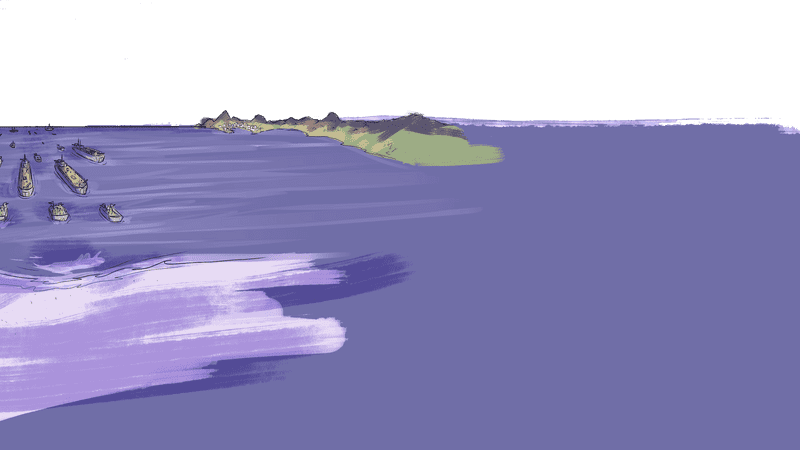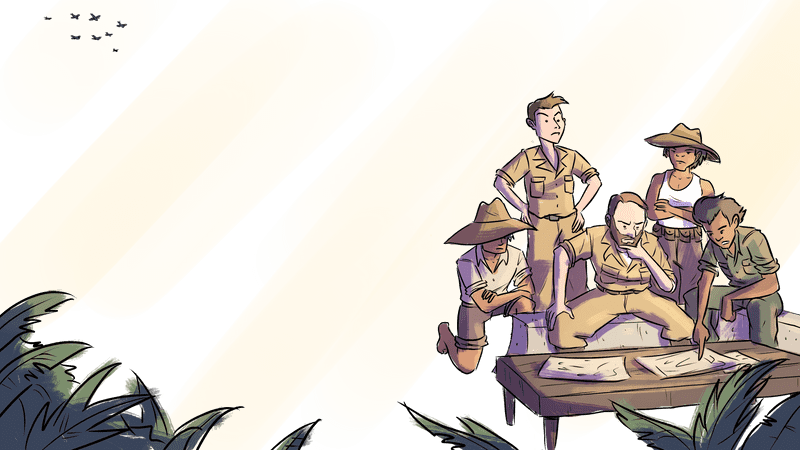Chapter Two: The Crucible of War
October, 1944
Liberation
By 1944, the tide of the war in the Pacific had turned.
By 1944, the tide of the war in the Pacific had turned. U.S. and allied forces won key battles at Guadalcanal, Tarawa, and Guam.
Determined to liberate his former home and make good on his promise that “I shall return,” General Douglas MacArthur convinced President Franklin Roosevelt that the Philippines must be next.
On the island of Leyte, news of Japan’s losses reached the guerrillas, who offered reconnaissance and logistical support. In return, USAFFE smuggled weapons and medicine in to the guerrillas in anticipation of the Leyte landings.
Captain Palisoc of guerrilla forces in Urbizondo shows enemy positions, January 12, 1945. University of Wisconsin
On October 20, the invasion began. General Douglas MacArthur watched from off the coast as troops landed at Tacloban. At his side was Carlos Romulo, an officer in the Philippine Commonwealth Army and a passionate advocate for U.S.-Philippine military cooperation.
Romulo had spent the war years traveling across the United States, educating the public about the war in the Philippines. “Americans simply did not know of the loyalty the Filipinos had shown to America and the loyalty the Americans who fought there had shown to their fellow Filipino soldiers,” he observed.
Carlos P. Romulo
January 14, 1899 – December 15, 1985
Journalist, soldier, diplomat, and statesmen
Carlos Romulo represented the Philippines on a global stage both during and after the war. In 1941, Romulo was awarded a Pulitzer Prize for his reporting on the impending war in Southeast Asia. His articles also caught the eye of Douglas MacArthur who, once the war broke out, inducted Romulo into the Army. Romulo’s “the Voice of Freedom” radio broadcast delivered news and attempted to boost public morale. After Bataan fell, Romulo traveled the U.S. to deliver his first-hand account of the war to American audiences. After the war, Romulo was an outspoken critic of the Rescission Act and lobbied U.S. Congress to secure rehabilitation funds for the Philippines. He also led the Philippine delegation to the newly formed United Nations. In 1949, Romulo became the first, and only, Filipino to serve as president of the United Nations General Assembly.
Joining MacArthur and Romulo were soldiers of the First and Second Filipino Infantry Regiments. These men were recent Filipino migrants who had volunteered or been drafted in the continental U.S. or Hawai’i during the war. Proudly wearing U.S. Army uniforms, the men of the First and Second Fil—about 9,000 in total—were rapidly naturalized as U.S. citizens.
Many Filipino Americans hoped that service in Uncle Sam’s army would challenge discrimination and prejudice they faced in North America. Filipinos and Americans would liberate the Philippines together.
Liberation
Days later, the forces at Tacloban fought off the Japanese defenders and consolidated their foothold. It was time to declare the restoration of the Philippine Commonwealth that had collapsed in 1942. Its president, Manuel Quezon, had died in 1944. Replacing him was his colleague and rival, Sergio Osmeña, the longtime independence advocate.
Sergio Osmeña
September 9, 1878 – October 19, 1961
President of the Philippine Commonwealth during transition to Philippine independence
One of the most dominant politicians of the colonial era, Sergio Osmeña became president of the Commonwealth in 1944. Born in 1878 in Cebu, an important trading port, Osmeña rose to prominence in 1907 when he was elected as to the highest-ranking position for a Filipino official—Speaker of the Philippine Assembly. Osmeña spent the war years in exile in the United States and assumed the presidency after the death of his main political rival, Manuel Quezon. in 1944, he returned to the Philippines, wading alongshore with General Douglas MacArthur at Leyte. In addition to re-establishing civil rule after liberation, under Osmeña the Philippines became 1 of 51 nations to sign the foundational Charter of the United Nations. In 1946, however, Osmeña lost the election to become the first president of an independent Philippine Republic to Manuel Roxas.
It was also time to rebuild the Philippine Commonwealth Army (PA). Rather than starting from scratch, Osmeña and MacArthur decided that the guerrillas would become part of the PA. On October 28, Osmeña issued a Presidential Order that incorporated guerrilla forces into the PA—and thereby into USAFFE.
Forged Under Fire
Calling for “equal pay for equal risk,” MacArthur even tried to boost the guerrillas’ wages to match those of American GIs. U.S. officials quickly overruled him. The guerrillas were now officially USAFFE soldiers, marching under MacArthur’s command and the American flag.
But they had only won the battle: the war to defeat the Japanese Empire remained ahead of them. Offshore in Leyte Gulf, a massive sea engagement brought the American and Japanese navies into direct conflict in the largest naval battle in history. Overhead flew a new and frightening menace: the kamikaze. Meaning “divine wind,” these suicide bombers first took off from Clark Field in October 1944 to attack U.S. ships.
After days of brutal and bloody conflict at sea, the U.S. won a decisive victory. As the troops marched out from their beachhead at Leyte across the archipelago, it was clear there was a long road ahead before any of America’s promises could be fulfilled.
“Landing in the Philippines was a joyous occasion and a somber one, as returning troops witnessed celebrations and misfortune in equal measures.”
An Untold Triumph: America's Filipino Soldiers
As the troops marched out from their beachhead at Leyte, it was clear there was a long road ahead before America’s promises could be fulfilled.
Next Section
October, 1944 – September, 1945
Devastation and Victory
Filipino guerrillas joined U.S. soldiers to defeat Japan and liberate the U.S. colony of the Philippines.
Explore



